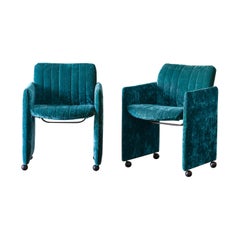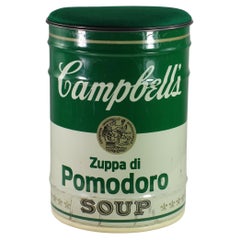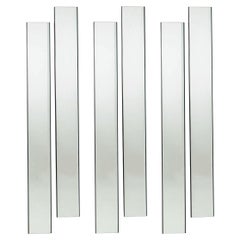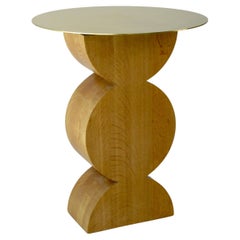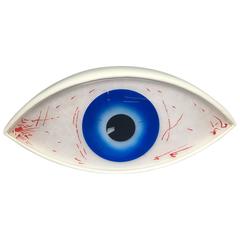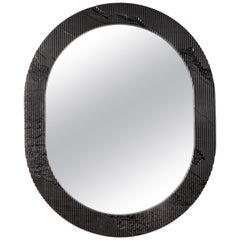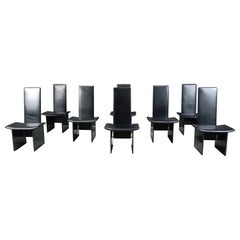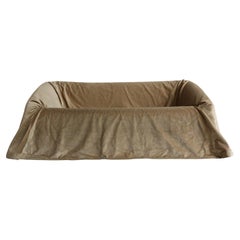Studio Simon Furniture
to
3
22
1
23
1
17
1
23
1
4
18
1
13
5
12
11
9
4
3
22
21
24
23
23
9
7,546
3,967
2,548
2,244
Creator: Studio Simon
Dino Gavina for Studio Simon, Andy Warhol Campbell's Soup Stool, Italy 1971
By Studio Simon, Dino Gavina
Located in Naples, IT
Rare Campbell' Soup stool designed by Dino Gavina as a tribute to Andy Warhol in 1971 for the Simon company as part of the seminal Ultramobile Exhibition- Collection (1971). Dino Gav...
Category
1970s Italian Mid-Century Modern Vintage Studio Simon Furniture
Materials
Metal
Pair of Kazuhide Takahama armchairs for Studio Simon, 1970s
By Studio Simon, Kazuhide Takahama
Located in Roma, RM
Pair of Kazuhide Takahama armchairs for studio simon, 1970s. Complete with cushions covered with Dedar “plushy” fabric
Product details
Literature: V. Vercelloni, The adventure of des...
Category
1970s Vintage Studio Simon Furniture
Materials
Fabric, Wood
1970 Campbell Soup Studio Simon Gavina Wahrol Christo Radical Design Stool
By Dino Gavina, Studio Simon
Located in Brescia, IT
Campbell Stool
Studio Simon
Italy, 1973
From the Ultramobile Series
Iconic Stool
Screenprint on Steel, Upholstery Cushion
Category
1970s Italian Mid-Century Modern Vintage Studio Simon Furniture
Materials
Metal
Set of 10 Otero Mirrors by Studio Simon Gavina, Italy 1980s (First Edition)
By Gavina, Studio Simon
Located in Argelato, BO
Created by Studio Simon Gavina, Otero is beveled on the vertical edges, its support being polyester painted, with a mirror-gloss finish. Like an arrow slit in the wall, or a slash of...
Category
1980s Italian Modern Vintage Studio Simon Furniture
Materials
Metal
Studio Simon, Constantin Occasional Table With Brass Top
By Studio Simon, Cassina
Located in Ferndale, MI
Studio Simon Constantin occasional table in oak wood with a polished brass top. The brass top appears to be floating on the thickset wood base. Italy, 1971 / 2013
Base measures 10.75...
Category
1970s Italian Post-Modern Vintage Studio Simon Furniture
Materials
Brass
Studio Simon Otero Mirror For Cassina
By Studio Simon
Located in Barcelona, Barcelona
Studio Simon Otero Mirror For Cassina
This design mirror produced by Studio Simon replicates a slit, a blade of light in the wall. An elongated rectangle that reflects everything ar...
Category
2010s Italian Mid-Century Modern Studio Simon Furniture
Materials
Glass
Carlo Scarpa & Marcel Breuer Naxos Marble “Delfi” Table for Studio Simon, 1969
By Studio Simon, Marcel Breuer, Carlo Scarpa
Located in Vicenza, IT
“Delfi” dining table, designed by Carlo Scarpa and Marcel Breuer and produced by the Italian manufacturer Studio Simon in 1969.
Made of white Nax...
Category
1960s Italian Mid-Century Modern Vintage Studio Simon Furniture
Materials
Marble
Studio Simon for Simon Gavina Italian Glass "Davide" Model Dining Table 1970s
By Simon Gavina Editions, Studio Simon
Located in Reggio Emilia, IT
Italian midcentury nodern design dining table “Davide “ model designed by Studio Simon and produced by Simon Gavina with partially foldable chrome-plated steel frame and clear glass ...
Category
1970s Italian Mid-Century Modern Vintage Studio Simon Furniture
Materials
Metal
Set of 8 Gaja chairs by Kazuhide Takahama for Studio Simon, 1980s
By Kazuhide Takahama, Studio Simon
Located in Leuven, Vlaams Gewest
Timeless design dining chairs by Kazuhide Takahama for Simon Italy. Model 'Gaja'
The chairs have a very fine but sturdy chromed frame and a new black leatherette upholstery.
The ch...
Category
1980s Italian Post-Modern Vintage Studio Simon Furniture
Materials
Chrome
Table ’Traccia’ by Meret Oppenheim for Simon Gavina, Italy, 1972
By Meret Oppenheim, Studio Simon
Located in Echt, NL
Original ’Traccia’ table in very good condition.
Designed by Meret Oppenheim
Produced by Studio Simon’s Collezione Ultramobili, Milan, 1972
The tabletop is covered in gold leaf and has bird tracks embossed in the surface.
The top rests on two brass feet in the form of bird legs.
The original table was exhibited by the Surrealist artist Meret Oppenheim in 1939 for the Parisian gallery René Drouin...
Category
20th Century Italian Mid-Century Modern Studio Simon Furniture
Materials
Brass, Gold Leaf
Rare Gloss Black Folding Table by Kazuhide Takahama
By Kazuhide Takahama, Studio Simon
Located in Dronten, NL
Rare early black lacquered square table by Kazuhide Takahama for Simon International that folds out to a rectangular table when desired. Magnificent lacquer quality, refined attentio...
Category
1970s Italian Mid-Century Modern Vintage Studio Simon Furniture
Materials
Plywood
Studio Simon Black Wood and Azure Velvet Two-Seater “Simone” Sofa, Italy, 1975
By Studio Simon
Located in Vicenza, IT
Two-seater “Simone” sofa, designed and manufactured by Studio Simon in 1975.
The structure is made of black lacquered wood. An azure velvet big seat completes the sofa.
The min...
Category
1970s Italian Mid-Century Modern Vintage Studio Simon Furniture
Materials
Cotton, Velvet, Foam
Carlo Scarpa Iroko Wood and Green Velvet Cornaro Sofa for Studio Simon, 1974
By Studio Simon, Carlo Scarpa
Located in Vicenza, IT
Cornaro two-seater sofa, designed by Carlo Scarpa and manufactured by Studio Simon in 1974.
Made of Iroko wood, foam, and azure chenille velvet.
Excellent vintage condition.
Born in Venice on June 2nd, 1906, Carlo Scarpa began working very early. Only a year after he had first qualified as an architect in 1926, he began working for the Murano glassmakers Cappellin & Co. in a consultative capacity; from 1927, he began to experiment with the Murano glass, and this research not only gave him excellent results here but would also inform his progress for many years to come. Between 1935 and 1937, as he entered his thirties, Carlo Scarpa accepted his first important commission, the renovation of Venice’s Cà Foscari. He adapted the spaces of this stately University building which stands on the banks of the Grand Canal, creating rooms for the Dean’s offices and a new hall for academic ceremonies; Mario Sironi and Mario De Luigi were charged with doing the restoration work on the frescos. After 1945, Carlo Scarpa was constantly busy with new commissions, including various furnishings and designs for the renovation of Venice’s Hotel Bauer and designing a tall building in Padua and a residential area in Feltre, all worth mentioning. One of his key works, despite its relatively modest diminished proportions, was the first of many works which were to follow in the nineteen fifties: the [bookshop known as the] Padiglione del Libro, which stands in Venice’s Giardini di Castello and shows clearly Scarpa’s passion for the works of Frank Lloyd Wright. In the years which were to follow, after he had met the American architect, Scarpa repeated similar experiments on other occasions, as can be seen, in particular, in the sketches he drew up in 1953 for villa Zoppas in Conegliano, which show some of his most promising work. However, this work unfortunately never came to fruition. Carlo Scarpa later created three museum layouts to prove pivotal in how twentieth-century museums were set up from then on. Between 1955 and 1957, he completed extension work on Treviso’s Gipsoteca Canoviana [the museum that houses Canova’s sculptures] in Possagno, taking a similar experimental approach to the one he used for the Venezuelan Pavilion at [Venice’s] Giardini di Castello which he was building at the same time (1954-56). In Possagno Carlo Scarpa was to create one of his most incredible ever works, which inevitably bears comparison with two other museum layouts that he was working on over the same period, those of the Galleria Nazionale di Sicilia, housed in the Palazzo Abatellis in Palermo (1953-55) and at the Castelvecchio in Verona (1957- 1974), all of which were highly acclaimed, adding to his growing fame. Two other buildings, which are beautifully arranged in spatial terms, can be added to this long list of key works that were started and, in some cases, even completed during the nineteen fifties. After winning the Olivetti Award for architecture in 1956, Scarpa began work in Venice’s Piazza San Marco on an area destined to house products made by the Industrial manufacturers Ivrea. Over the same period (1959-1963), he also worked on renovating and restoring the gardens and ground floor of the Fondazione Querini Stampalia in Venice, which many consider one of his greatest works. While he worked on-site at the Fondazione Querini Stampalia, Carlo Scarpa also began building a villa in Udine for the Veritti family. To shed some light on how much his work evolved over the years, it may be useful to compare this work with that of his very last building, villa Ottolenghi Bardolino, which was near completion at the time of his sudden death in 1978. Upon completion of villa Veritti over the next ten years, without ever letting up on his work on renovation and layouts, Scarpa accepted some highly challenging commissions which were to make the most of his formal skills, working on the Carlo Felice Theatre in Genoa as well as another theatre in Vicenza.
Towards the end of this decade, in 1969, Rina Brion commissioned Carlo Scarpa to build the Brion Mausoleum in San Vito d’Altivole (Treviso), a piece he continued to work on right up until the moment of his death. Nevertheless, even though he was totally absorbed by work on this mausoleum, plenty of other episodes can offer some insight into the final years of his career. As work on the San Vito d’Altivole Mausoleum began to lessen in 1973, Carlo Scarpa started building the new headquarters for the Banca Popolare di Verona. He drew up plans that were surprisingly different from the work he carried out simultaneously on the villa Ottolenghi. However, the plans Carlo Scarpa drew up, at different times, for a monument in Brescia’s Piazza della Loggia commemorating victims of the terrorist attack on May 28th, 1974, make a sharp contrast to the work he carried out in Verona, almost as if there is a certain hesitation after so many mannered excesses. The same Pietas that informs his designs for the Piazza Della Loggia can also be seen in the presence of the water that flows through the Brion Mausoleum, almost as if to give a concrete manifestation of pity in this twentieth-century work of art. Carlo Scarpa has put together a highly sophisticated collection of structures occupying the mausoleum’s L-shaped space stretching across both sides of the old San Vito d’Altivole cemetery. A myriad of different forms and an equally large number of different pieces, all of which are separate and yet inextricably linked to form a chain that seems to offer no promise of continuity, arising out of these are those whose only justification for being there is to bear the warning “si vis vitam, para mortem,” [if you wish to experience life prepare for death] as if to tell a tale that suggests the circle of time, joining together the commemoration of the dead with a celebration of life. At the entrance of the Brion Mausoleum stand the “propylaea,” followed by a cloister that ends by a small chapel, with an arcosolium bearing the family sarcophagi, the central pavilion, held in place on broken cast iron supports, stands over a mirror-shaped stretch of water and occupies one end of the family’s burial space. The musical sound of the walkways, teamed with the luminosity of these harmoniously blended spaces, shows how, in keeping with his strong sense of vision, Carlo Scarpa could make the most of all his many skills to come up with this truly magnificent space. As well as an outstanding commitment to architectural work, with the many projects we have already seen punctuating his career, Carlo Scarpa also made many equally important forays into the world of applied arts. Between 1926 and 1931, he worked for the Murano glassmakers Cappellin, later taking what he had learned with him when he went to work for the glassmakers Venini from 1933 until the 1950s. The story of how he came to work on furniture design is different, however, and began with the furniture he designed to replace lost furnishings during his renovation of Cà Foscari. The later mass-produced furniture started differently, given that many pieces were originally one-off designs “made to measure.” Industrial manufacturing using these designs as prototypes came into being thanks to the continuity afforded him by Dino Gavina, who, as well as this, also invited Carlo Scarpa to become president of the company Gavina SpA, later to become SIMON, a company Gavina founded eight years on, in partnership with Maria Simoncini (whose own name accounts for the choice of company name). Carlo Scarpa and Gavina forged a strong bond in 1968 as they began to put various models of his into production for Simon, such as the “Doge” table, which also formed the basis for the “Sarpi” and “Florian” tables. In the early seventies, other tables that followed included “Valmarana,” “Quatour,” and “Orseolo.” While in 1974, they added a couch and armchair, “Cornaro,” to the collection and the “Toledo” bed...
Category
1970s Italian Mid-Century Modern Vintage Studio Simon Furniture
Materials
Velvet, Foam, Chenille, Wood
Studio Simon Granite Brutalist Samo Table in the Style of Carlo Scarpa, 1970
By Studio Simon, Carlo Scarpa
Located in Vicenza, IT
Dining table mod. ‘Samo’ by Studio Simon. Series ‘Ultrarazionale’. Italy, 1970.
Made of granite.
Literature: Giuliana Gramigna, Repertorio 1950-2000, Allemandi, Torino, 2003, p.180.
Excellent vintage condition.
The Samo table was designed in 1970 by the project office of Studio Simon. Carlo Scarpa was the brand's artistic director, and the Venetian architect's style inspired the shapes of this table.
Born in Venice on June 2nd, 1906, Carlo Scarpa began working at a very early age. Only a year after he had first qualified as an architect in 1926, he began working for the Murano glassmakers Cappellin & Co. in a consultative capacity; from 1927, he began to experiment with the Murano glass, and this research not only gave him excellent results here but would also inform his progress for many years to come. Between 1935 and 1937, as he entered his thirties, Carlo Scarpa accepted his first important commission, the renovation of Venice’s Cà Foscari. He adapted the spaces of this stately University building which stands on the banks of the Grand Canal, creating rooms for the Dean’s offices and a new hall for academic ceremonies; Mario Sironi and Mario De Luigi were charged with doing the restoration work on the frescos. After 1945, Carlo Scarpa found himself constantly busy with new commissions, including various furnishings and designs for the renovation of Venice’s Hotel Bauer and designing a tall building in Padua and a residential area in Feltre, which are all worth mention. One of his key works, despite its relatively modest diminished proportions, was the first of many works which were to follow in the nineteen fifties: the [bookshop known as the] Padiglione del Libro, which stands in Venice’s Giardini di Castello and shows clearly Scarpa’s passion for the works of Frank Lloyd Wright. In the years which were to follow, after he had met the American architect, Scarpa repeated similar experiments on other occasions, as can be seen, in particular, in the sketches he drew up in 1953 for villa Zoppas in Conegliano, which show some of his most promising work. However, this work unfortunately never came to fruition. Carlo Scarpa later created three museum layouts to prove pivotal in terms of how 20th century museums were to be set up from then on. Between 1955 and 1957, he completed extension work on Treviso’s Gipsoteca Canoviana [the museum that houses Canova’s sculptures] in Possagno, taking a similar experimental approach to the one he used for the Venezuelan Pavilion at [Venice’s] Giardini di Castello which he was building at the same time (1954-56). In Possagno Carlo Scarpa was to create one of his greatest ever works, which inevitably bears comparison with two other museum layouts that he was working on over the same period, those of the Galleria Nazionale di Sicilia, housed in the Palazzo Abatellis in Palermo (1953-55) and at the Castelvecchio in Verona (1957- 1974), all of which were highly acclaimed, adding to his growing fame. Two other buildings, which are beautifully arranged in spatial terms, can be added to this long list of key works that were started and, in some cases, even completed during the nineteen fifties. After winning the Olivetti award for architecture in 1956, Scarpa began work in Venice’s Piazza San Marco on an area destined to house products made by the Industrial manufacturers Ivrea. Over the same period (1959-1963), he also worked on renovation and restoration of the gardens and ground floor of the Fondazione Querini Stampalia in Venice, which many consider being one of his greatest works. While he busied himself working on-site at the Fondazione Querini Stampalia, Carlo Scarpa also began work building a villa in Udine for the Veritti family. To shed some light on the extent to which his work evolved over the years, it may perhaps be useful to compare this work with that of his very last building, villa Ottolenghi Bardolino, which was near to completion at the time of his sudden death in 1978. Upon completion of villa Veritti over the next ten years, without ever letting up on his work on renovation and layouts, Scarpa accepted some highly challenging commissions which were to make the most of his formal skills, working on the Carlo Felice Theatre in Genoa as well as another theatre in Vicenza.
Towards the end of this decade, in 1969, Rina Brion commissioned Carlo Scarpa to build the Brion Mausoleum in San Vito d’Altivole (Treviso), a piece he continued to work on right up until the moment of his death. Nevertheless, even though he was totally absorbed by work on this mausoleum, there are plenty of other episodes which can offer some insight into the final years of his career. As work on the San Vito d’Altivole Mausoleum began to lessen from 1973, Carlo Scarpa began work building the new headquarters for the Banca Popolare di Verona. He drew up plans that were surprisingly different from the work he was carrying out at the same time on the villa Ottolenghi. However, the plans Carlo Scarpa drew up, at different times, for a monument in Brescia’s Piazza della Loggia commemorating victims of the terrorist attack on May 28th, 1974, make a sharp contrast to the work he carried out in Verona, almost as if there is a certain hesitation after so many mannered excesses. The same Pietas that informs his designs for the Piazza Della Loggia can also be seen in the presence of the water that flows through the Brion Mausoleum, almost as if to give a concrete manifestation of pity in this 20th century work of art. Carlo Scarpa has put together a highly sophisticated collection of structures, occupying the mausoleum’s L-shaped space stretching across both sides of the old San Vito d’Altivole cemetery. A myriad of different forms and an equally large number of different pieces, all of which are separate and yet inextricably linked to form a chain that seems to offer no promise of continuity, rising up out of these are those whose only justification for being there is to bear the warning “si vis vitam, para mortem”, [if you wish to experience life prepare for death] as if to tell a tale that suggests the circle of time, joining together the commemoration of the dead with a celebration of life. At the entrance of the Brion Mausoleum stand the “propylaea” followed by a cloister which ends by a small chapel, with an arcosolium bearing the family sarcophagi, the main pavilion, held in place on broken cast iron supports, stands over a mirror-shaped stretch of water and occupies one end of the family’s burial space. The musical sound of the walkways teamed with the luminosity of these harmoniously blended spaces shows how, in keeping with his strong sense of vision, Carlo Scarpa could make the most of all of his many skills to come up with this truly magnificent space. As well as a great commitment to architectural work, with the many projects which we have already seen punctuating his career, Carlo Scarpa also made many equally important forays into the world of applied arts. Between 1926 and 1931, he worked for the Murano glassmakers Cappellin, later taking what he had learned with him when he went to work for the glassmakers Venini from 1933 until the 1950s. The story of how he came to work on furniture design is different, however, and began with the furniture he designed to replace lost furnishings during his renovation of Cà Foscari. The later mass-produced furniture started differently, given that many pieces were originally one-off designs “made to measure”. Industrial manufacturing using these designs as prototypes came into being thanks to the continuity afforded him by Dino Gavina, who, as well as this, also invited Carlo Scarpa to become president of the company Gavina SpA, later to become SIMON, a company Gavina founded 8 years on, in partnership with Maria Simoncini (whose own name accounts for the choice of company name). Carlo Scarpa and Gavina forged a strong bond in 1968 as they began to put various models of his into production for Simon, such as the “Doge” table, which also formed the basis for the “Sarpi” and “Florian” tables. In the early seventies, other tables that followed included “Valmarana”, “Quatour” and “Orseolo”. While in 1974, they added couch and armchair “Cornaro” to the collection and the “Toledo” bed...
Category
1970s Italian Mid-Century Modern Vintage Studio Simon Furniture
Materials
Granite
Constantin wood side table by Gavina, Homage to Brancusi, 1971 (First Edition)
By Studio Simon, Gavina
Located in Argelato, BO
Constantin Side Table, Homage to Brancusi by Gavina, Italy, 1971. (First Edition)
The Constantin designer coffee table is a work of art included...
Category
1970s Italian Mid-Century Modern Vintage Studio Simon Furniture
Materials
Brass
Set of 2 "Tomasa" chairs, Paolo Uccello - Studio Simon, 1983
By Studio Simon
Located in Milano, Lombardia
Pair of folding chairs model "Tomasa" in oak wood Production Simon-Ultramobile, Italy, 1983. Provenance: Milan Private Collection. Signs consistent with time and wear.
Category
1980s Italian Post-Modern Vintage Studio Simon Furniture
Materials
Wood
Sofa "Simone" 3 seater Studio Simon by Gavina glossy black lacquered
By Studio Simon, Gavina
Located in Milano, MI
Elegant "Simone" Sofa Designed by Dino Gavina for Studio Simon in the 1970s.
The black glossy lacquered wood frame allows it to be placed in the center of the room having a very eleg...
Category
Mid-20th Century Italian Mid-Century Modern Studio Simon Furniture
Materials
Velvet, Wood
Table "Bisanzio" des. Carlo Scarpa and Hiroyuki Toyoda for Simon 1973
By Studio Simon
Located in Melbourne, VIC
Elegant Dining table designed by Carlo Scarpa and produced by Simon. Following the death of Scarpa, the design was refined and finished by Hiroyuki Toyoda in conjunction with Dino ...
Category
Mid-20th Century Italian Mid-Century Modern Studio Simon Furniture
Davide Table by Studio Simon, 1970
By Studio Simon
Located in Ozzano Dell'emilia, IT
Davide table designed by Studio Simon and produced by Simon.
Partially foldable chromed steel structure, transparent glass top.
Bibliography:
Fondazione Scientifica Querini Stampal...
Category
1970s Italian Mid-Century Modern Vintage Studio Simon Furniture
Materials
Steel
Lacquered 3-seater sofa and leather Studio Simon by Gavina
By Studio Simon, Dino Gavina
Located in Milano, MI
Elegant "Simone" Sofa Designed by Dino Gavina for Studio Simon in the 1970s.
Cushions upholstered in black leather and polyester lacquered wood frame, glossy black.
Sofa frame solid...
Category
Mid-20th Century Italian Mid-Century Modern Studio Simon Furniture
Materials
Leather, Wood
Exceptional Studio Simon Nidone Chair by Giulietto Cacciari
By Studio Simon
Located in Dronten, NL
Nidone armchair designed by Giulietto Cacciari.
Enameled steel "oil barrel" base, padded and covered in fabric.
Produced by Studio Simon, Italy, 1974.
Marked underneath the seat.
Do...
Category
1970s Italian Mid-Century Modern Vintage Studio Simon Furniture
Materials
Steel
“Sforzesca” armchair by Studio Simon, homage to Castiglioni, 1980s
By Studio Simon
Located in Roma, RM
“Sforzesca” Armchair by Studio Simon, Homage to Castiglioni, 1980s
Product Details:
This distinguished “Sforzesca” armchair, designed by Studio Simon in the 1980s, serves as an homa...
Category
1980s Italian Vintage Studio Simon Furniture
Materials
Fabric, Wood
Kazuhide Takahama for Simon Gavina Set of Three Chairs, Italy, 1970s
By Kazuhide Takahama, Studio Simon
Located in Naples, IT
Beautiful and rare set of 3 chairs designed by Kazuhide Takahama for Simon Gavina, Italy 1970s, in metallic grey velvet and steel frame, with velvet arm covers. The chairs are in goo...
Category
1970s European Mid-Century Modern Vintage Studio Simon Furniture
Materials
Metal
“Sforzesca” armchair by Studio Simon, homage to Castiglioni (Customizable)
By Studio Simon, Gavina
Located in Argelato, BO
Rare and beautiful "Sfozesca" model armchair in green fabric, designed in the 1980s by Studio Simon. It is a truly original chair, with a strong personality and refined lines
The fab...
Category
1980s Post-Modern Vintage Studio Simon Furniture
Materials
Fabric, Wood
Related Items
'Le Temoin' Stool by Man Ray for Gavina
By Man Ray, Gavina
Located in Little Burstead, Essex
Beautiful example in pristine condition, designed by Man Ray for Gavina's ultramobile exhibition.
Category
1970s Italian Mid-Century Modern Vintage Studio Simon Furniture
Materials
Acrylic, Foam, Plywood, Faux Leather
Shale Mirror in Black by Simon Johns
By Simon Johns
Located in East-Bolton, Quebec
Bringing the serenity of the outdoors into the home, the Shale mirror has a distinct texture carved across the frames surface that seems to reach beyond it's limits. The solid ash surface is scored vertically across the grain, and the drawing of Simon Johns’ textures of a crumbling cliff's facade is delicately carved into it. Patterns within the carving and the wood's grain create optical illusions depending on the lights orientation, making it as striking from afar as from up close. Due to the hand-carved facade...
Category
2010s Canadian Modern Studio Simon Furniture
Materials
Ash, Mirror
Mid Century Italian Smoked Wall Mirror 1980s
Located in Los Angeles, CA
The Mid Century Italian Smoked Wall Mirror from the 1980s features a sleek smoked glass design, embodying the style of the era.
Category
1980s Italian Mid-Century Modern Vintage Studio Simon Furniture
Materials
Mirror, Wood
Pink Mirror by Studio Glustin
By Glustin Creation
Located in Saint-Ouen (PARIS), FR
Oval mirror with frame in sculpted Murano glass and brass inlays.
Creation by Studio Glustin.
Category
21st Century and Contemporary Italian Mid-Century Modern Studio Simon Furniture
Materials
Brass
Vintage Italian Brass Wall Mirror 1980s
Located in Los Angeles, CA
The Vintage Italian 1980s Brass Wall Mirror is a classic and timeless piece with a beautiful brass finish.
Category
1980s Italian Mid-Century Modern Vintage Studio Simon Furniture
Materials
Brass
1980s Large Fiber glass Wall Mirror , Italy
Located in Praha, CZ
- Good original condition with some signs of use
- Mirror itself in good condition
Category
Mid-20th Century Italian Mid-Century Modern Studio Simon Furniture
Materials
Mirror, Glass, Fiberglass
Murano Glass Mirror by Studio Glustin
By Glustin Creation
Located in Saint-Ouen (PARIS), FR
Exceptional mirror with a frame in sculpted and braided Murano glass.
Creation by Studio Glustin.
Italy, 2021.
(Pair available)
Category
2010s Italian Mid-Century Modern Studio Simon Furniture
Materials
Mirror, Murano Glass
Painted Italian Carved Occasional Table with Round Carrara Marble Top
Located in West Palm Beach, FL
Painted occasional or end table, having a round top of Carrara marble, its pierced apron carved with foliate scrollwork, raised on four, round, bowed legs, each headed with a rosette...
Category
Mid-20th Century Italian Studio Simon Furniture
Materials
Carrara Marble
Chair model "Jano" design Kazuide Takahama For Simon Gavina, 1970s
By Gavina, Kazuhide Takahama
Located in taranto, IT
Rare chair model jano design kazuide takahama for Simon gavina , 1970s
Structure in tubular steel and seat and back upholstery in fabric
Height 81 cm, width 53 cm, depth 54 cm...
Category
1970s Vintage Studio Simon Furniture
Materials
Steel
Constantin wood side table by Gavina, Homage to Brancusi, 1971 (First Edition)
By Studio Simon, Gavina
Located in Argelato, BO
Constantin Side Table, Homage to Brancusi by Gavina, Italy, 1971. (First Edition)
The Constantin designer coffee table is a work of art included...
Category
1970s Italian Mid-Century Modern Vintage Studio Simon Furniture
Materials
Brass
Pair of Tall Back Studio Bar Stools, US, 1970s
Located in Berlin, DE
Pair of tall back studio bar stools in ash.
Category
1970s American Mid-Century Modern Vintage Studio Simon Furniture
Materials
Ash
Armchair by Kazuhide Takahama for Simon / Gavina by Cassina, Italy, 1960s
By Kazuhide Takahama
Located in modena, Emilia-Romagna
The success of lacquered models has slowly invested the world market, adding another medal to the history of Italian design.
It is in this fervor (we come to 1970) that the Kazuki c...
Category
1960s Italian Mid-Century Modern Vintage Studio Simon Furniture
Materials
Beech, Lacquer
H 41.74 in W 18.12 in D 18.12 in
Previously Available Items
Rennie Dining Chairs by Kazuhide Takahama, 1970, Set of 8
By Studio Simon, Kazuhide Takahama
Located in Leuven, Vlaams Gewest
Stunning 'Rennie' dining chairs designed by Kazuhide Takahama for Studio Simon.
They where produced from 1970 to 1979.
Made from black lacquer wooden frames and leather seats and ...
Category
1970s Italian Post-Modern Vintage Studio Simon Furniture
Materials
Leather, Lacquer
Kazuhide Takahama Mantilla Two-Seater Sofa for Studio Simon, 1973
By Studio Simon, Kazuhide Takahama
Located in London, GB
An immaculate two seater sofa by Kazuhide Takahama for Studio Simon. This 1973 classic takes its styling from the idea of a sofa throw, but makes it bespoke. The base is wood and pol...
Category
1970s Italian Mid-Century Modern Vintage Studio Simon Furniture
Materials
Velvet, Foam, Plywood
Set of Six Tulu Chairs by Kazuhide Takahama for Simon Gavina
By Kazuhide Takahama, Studio Simon
Located in Dronten, NL
The Tulu chair was designed by the Japanese designer Kazuhide Takahama for Simon International in 1966.
The Tulu is one of the very first models that paved the way for the use of chrome-plated steel rod. The steel rod makes it possible to produce softly curved, extremely rounded structures. The back and seat upholstery is attached with zippers and completely removable.
The dark blue Alcantara fabric is great, it is the Italian version of Ultrasuede. It feels like natural suede, but it is resistant to stains and discoloration; it can be washed in a washing machine.
These elegant stackable chairs are in very good all original condition.
They are an early production of Simon International and marked with a silver foil label inside the seat.
This set was bought by the original owners in 1970 together with a Sarpi table...
Category
1960s Italian Mid-Century Modern Vintage Studio Simon Furniture
Materials
Steel, Chrome
Ming Coffee Table by Kazuhide Takahama, 1970s
By Studio Simon, Kazuhide Takahama
Located in Leuven, Vlaams Gewest
Black lacquered coffee table model 'Ming' designed by Kazuhide Takahama and produced by Studio Simon.
This very large coffee table is very simply designed yet looks beautiful.
...
Category
1970s Italian Mid-Century Modern Vintage Studio Simon Furniture
Materials
Lacquer
Studio Simon Minimalist Black Leather Three-Seater “Simone” Sofa, Italy, 1975
By Studio Simon
Located in Vicenza, IT
Three-seater “Simone” sofa, designed and manufactured by Studio Simon in 1975.
The structure is made of black lacquered wood. A black leather big seat completes the sofa.
The m...
Category
1970s Italian Mid-Century Modern Vintage Studio Simon Furniture
Materials
Foam, Leather, Beech
H 20.48 in W 82.68 in D 31.89 in
Set of Six Chairs Kazuhide Takahama Model 'Jano' for Simon, 1970s
By Studio Simon, Kazuhide Takahama
Located in Leuven, Vlaams Gewest
Timeless designed dining chairs by Kazuhide Takahama for Simon Italy. Model 'Jano'
Designed end of the 1960s and these where produced in the seventies.
The chairs have a very f...
Category
1970s Italian Mid-Century Modern Vintage Studio Simon Furniture
Materials
Chrome
Dino Gavina for Studio Simon, Andy Warhol Campbell’s Soup Can Stool, Italy, 1971
By Dino Gavina, Studio Simon
Located in Brooklyn, NY
Dino Gavina for Studio Simon, Homage to Andy Warhol: Campbell’s soup can stool, Italy, 1971.
Rare stool designed by Dino Gavina as a tribute to Andy Wa...
Category
1970s Italian Mid-Century Modern Vintage Studio Simon Furniture
Materials
Metal
Andy Warhol Campbell Soup Can Stool by Dino Gavina for Studio Simon 1970s
By Studio Simon, Dino Gavina
Located in Aachen, NW
This rare stool was designed by Dino Gavina as a tribute to Andy Warhol and produced by Studio Simon in 1971 as part of the seminal Ultramobile Exhibition- Collection.
The piece fe...
Category
1970s Italian Vintage Studio Simon Furniture
Materials
Metal
H 17.33 in W 12.21 in D 12.21 in
Andy Warhol Campbell Soup Can Stool by Dino Gavina for Studio Simon, 1970s
By Studio Simon, Dino Gavina
Located in Aachen, NW
This rare stool was designed by Dino Gavina as a tribute to Andy Warhol and produced by Studio Simon in 1971 as part of the seminal Ultramobile Exhibition- Collection.
The piece ...
Category
1970s Italian Vintage Studio Simon Furniture
Materials
Metal
H 17.33 in W 12.21 in D 12.21 in
Pair of Meret Openheim 'Traccia' tables, c1970
By Studio Simon, Meret Oppenheim
Located in London, GB
A pair of restored Meret Openheim 'Traccia' tables for Studio Simon.
A superb pair of Surrealist tables designed by Meret Openheim in the 1930s. Fully restored.
Category
1970s Italian Mid-Century Modern Vintage Studio Simon Furniture
Materials
Bronze
2 Lacquered and Green Velvet Simone Armchairs by Dino Gavina for Simon 70s
By Dino Gavina, Studio Simon
Located in Padova, IT
Rare pair of green velvet armchairs, designed by Dino Gavina and Maria Simoncini for Simon International 1970s.
Striking pair of armchai...
Category
1970s European Mid-Century Modern Vintage Studio Simon Furniture
Materials
Velvet, Wood
H 27.56 in W 35.44 in D 31.5 in
Pair of Iris Pendants by Hiroyuki Tsugawa & Studio Simon for Sirrah, 1980s
By Studio Simon, Sirrah
Located in Rotterdam, NL
Pair of Iris pendants designed by Hiroyuki Tsugawa together with Studio Simon and manufactured by Sirrah in the 1980s.
The model consists of a metal shade with black rubber edge a...
Category
1980s Italian Mid-Century Modern Vintage Studio Simon Furniture
Materials
Metal
Studio Simon furniture for sale on 1stDibs.
Studio Simon furniture are available for sale on 1stDibs. These distinctive items are frequently made of wood and are designed with extraordinary care. There are many options to choose from in our collection of Studio Simon furniture, although brown editions of this piece are particularly popular. Many of the original furniture by Studio Simon were created in the mid-century modern style in europe during the 20th century. If you’re looking for additional options, many customers also consider furniture by Adriano Piazzesi, Giovannetti, and Stilwood. Prices for Studio Simon furniture can differ depending upon size, time period and other attributes — on 1stDibs, these items begin at $1,668 and can go as high as $40,049, while a piece like these, on average, fetch $5,403.

